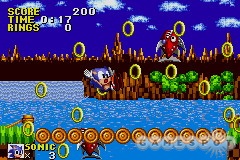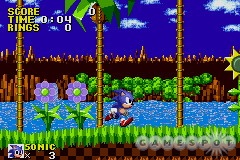In 1991, Sega made everyone rethink their concept of a side-scrolling platform game. That's the year the company published Sonic the Hedgehog for its Sega Genesis console. Nintendo's Mario games typically focused on gradual progress through a level and cautious jumping, but Sonic emphasized blazing speed. While Mario was relatively slow, Sonic could run like the wind. Mario was impish and stale, Sonic was skinny and cool. Back then, Sega's blue hedgehog simultaneously revolutionized the platform genre and gave people a legitimate alternative to Nintendo's fat plumber. To celebrate that landmark moment in video game history, Sega, in a flash of delicious irony, has brought Sonic's original adventure to Nintendo's Game Boy Advance handheld. As the title suggests, Sonic the Hedgehog Genesis strives to be a pixel-for-pixel replica of the original Sega Genesis game. All of the grassy hills, speedy loops, and bouncy pinball bumpers look exactly as they did on the Genny, only now they're coming to you on the GBA. Further sweetening the pot, it also implements some welcome improvements, such as a save feature, a level select, and a mode that incorporates Sonic's spin-dash move from later games. Unfortunately, there's just one very big problem: The GBA doesn't seem to be able to keep up with Sonic's speed, and that completely breaks the game.

If you get your hands on a copy of the original game and pop it into an actual Sega Genesis, you'll find that everything moves fast and fluidly. The GBA port, by contrast, seems to have an insane amount of trouble keeping up with the swift blue hero. The screen stutters when Sonic leans into a run or bounces off a springboard, and the action absolutely slows to a crawl when you grab an invincibility power-up. That's a ruinous problem for a game that's oriented so much around fast movements and quick reflexes. On top of that, enemies and floating platforms that used to gradually move into view as the screen scrolled now often just materialize right in front of Sonic. Many times, you'll lose rings or lives because you ran into something dangerous that wasn't visible until you were barely a few pixels away from it. Taken together, these problems kill any sense of speed the game once had and frequently lead to mishaps that are totally out of the player's hands.
It's a crying shame that the dodgy graphics have ruined the game, because the game gets a lot of other things right. Immediately after popping in the cartridge, players are greeted with the classic "Say-guh" chant that accompanied the Sega logo in the original game. A large portrait of Sonic waving his finger leads into the main menu, which reveals the game's two play modes. The original mode is the classic Genesis game, with seven zones, 21 main levels, and five bonus levels. There's also a new anniversary mode. It's roughly identical to the original mode, except that Sonic can perform the spin-dash ability that was added in Sonic 2. Regardless of which mode you pick, the game will save your progress so that you can quit at any time and pick up right where you left off. They've also implemented a zone select, which lets you start a new game and skip ahead to any zone that you've already completed. Both of these features are welcome upgrades compared to the original Genesis game, which didn't have a backup feature and required players to enter a cheat code in order to skip levels.
After all these years, the underlying graphics, audio, and gameplay still hold up. The side-scrolling levels are lush and vibrant, especially the Green Hill Zone and Star Light Zone, which make use of nifty waterfall and laser-show effects. Sonic looked sleek on the Genesis with his spiky blue hair, big white eyes, and red tennis shoes, and he looks just as sharp on the GBA. The characters, in general, are expressive and good-sized, although some of that is admittedly due to way the graphics have been cropped to account for the GBA's smaller screen dimensions. This cropping cuts away some of the view up ahead, but not so much that you don't have time to react to things--when the system can manage to draw them, of course. Fans that played the original game and have keen ears will notice that the music has been remixed and that the sound effects are higher in pitch. Some of the tunes sound really close to the original compositions and some are vastly different. They're all generally upbeat and pleasing to the ear though. Keen eyes will also notice that Sonic doesn't always recoil from hits or bounce off of springboards exactly as he did in the original game. For whatever reason, sometimes Sonic just bounces the wrong way or comes to a dead stop. These differences in physics aren't pervasive and they rarely affect gameplay in a negative way, but they do give fans something else to dislike besides the broken frame rate.
In theory, gameplay is satisfying and easy to get into, except for the fact that the graphical issues basically break it. Sonic can run, jump, and pop enemies or item containers by bouncing on top of them. If you're playing the anniversary mode, you can press the A button to charge and release a spin-dash, which launches Sonic forward at breakneck speed and obliterates most enemies in his path. The game wasn't really designed with the spin-dash in mind, but its inclusion doesn't break anything, either. It's mainly just a good way to build up speed in a pinch. Levels aren't necessarily tough to get through, but getting through them with a decent stash of gold rings is often quite a challenge. As long as you've picked up at least one ring, you won't lose a life if Sonic runs into an enemy or hazard. Such a run-in, however, will cause Sonic to drop all of the rings he's carrying. Since you need lots of rings to get high scores and access the chaos emerald bonus levels, you'll find yourself trying hard to avoid enemies so that you can hold on to those golden goodies.

Thanks to the busted frame rate, however, every single one of those high points is irrelevant. It's downright impossible to enjoy the timeless design, the bright visuals, and the peppy music when you're losing lives all the time because the screen can't keep up. Putting in all these extra features into the game and then forgetting to fix the one thing that would actually make it playable is simply ridiculous.
Around the same time that the original Sonic the Hedgehog came out, Sega was running an advertising campaign with the slogan "Genesis does what Nintendon't." It's almost as if this game was some sort of mean-spirited attempt to prove that old slogan, as Nintendo's Game Boy Advance sure doesn't seem to be able to handle a straight port of a game that came out on the Genesis a full decade before the GBA even hit store shelves. Or maybe Sega just didn't give the development team enough time and resources to work the kinks out. Whatever the case may be, Sonic the Hedgehog Genesis for the Game Boy Advance is a crushing disappointment.